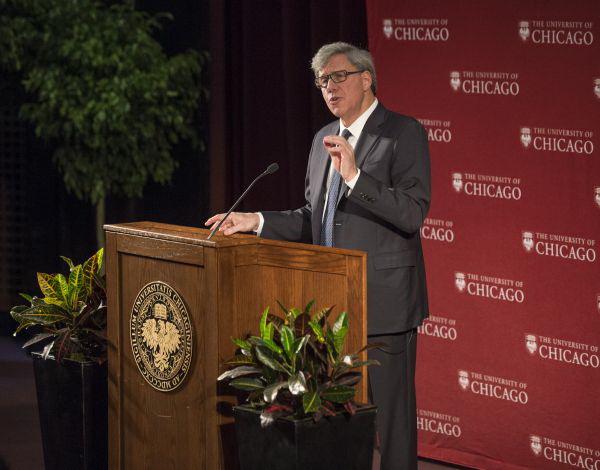‘On the Threshold of a New Era’: Prof. Geoffrey Stone on Same-Sex Marriage

With national speculation mounting about today’s U.S. Supreme Court arguments on same-sex marriage, Professor Geoffrey R. Stone told the audience at the University’s annual Nora and Edward L. Ryerson Lecture that he expects the Court this spring to recognize the constitutional right of gay couples to marry — and he underscored the magnitude of the anticipated decision by offering a powerful, and at times emotional, account of the nation’s fraught legal and social history with gay rights.
“Twenty-five years ago no one in this room would have imagined that the Supreme Court of the United States might hold that homosexuals had a constitutional right to marry one another,” said Stone, the Edward H. Levi Distinguished Service Professor of Law, during last week’s talk, “Sexing the Constitution: Getting to Gay Marriage?” The lecture, given each year by a University of Chicago faculty member who has made research contributions of lasting significance, was drawn from Stone’s next book, Sexing the Constitution, and partly chosen because the Supreme Court is expected to rule this June on the four gay marriage cases that have been consolidated as Obergefell v. Hodges. Unlike previous cases before the Court, Obergefell directly asks whether state laws that prohibit same-sex marriage violate the constitution.
Stone told the audience that he expects at least five justices to decide in favor of gay marriage; the real question is who will join them and what explanation they will give for their decision. He expects Justice Anthony Kennedy, who wrote the majority opinions in three other gay-rights cases, to author the decision — “a privilege,” Stone said, “he has earned.”
Stone’s lecture offered a sweeping account of changing attitudes toward homosexuality, beginning with the general acceptance of gay sex among ancient Greeks and Romans and the shift toward condemnation as Christianity emerged, then moving through an American history in which homosexuals were largely isolated and invisible and sometimes punished, and finally charting the rapid shift toward public acceptance in recent decades. He also traced the evolution of Supreme Court interpretation through four landmark cases: Bowers v. Hardwick (1986), which upheld the constitutionality of a Georgia sodomy law; Romer v. Evans (1996), which overturned a Colorado amendment prohibiting protected status for gays; Lawrence v. Texas (2003), which overturned Bowers; and United States v. Windsor (2013), which struck down part of the federal Defense of Marriage Act.
As he spoke, Stone painted a vivid picture of a nation hurtling toward change, even choking up as he described the celebratory aftermath of Lawrence, a turning point that occurred just 12 years ago.
“For the gay and lesbian community, it was an occasion for dancing in the streets,” Stone said. Quoting Flagrant Conduct, a 2012 book by Dale Carpenter, ’92, Stone added that “Lawrence meant that never again would their rights be dismissed by the highest tribunal in the land as, at best, facetious. Never again would they wonder whether the words engraved in the pediment of the Supreme Court building, ‘equal justice under law,’ included them.”
Around this time, public opinion — which had begun to shift after the AIDS crisis brought gay issues to the forefront of national consciousness — began veering more sharply toward acceptance and mainstream visibility. The 1990s had seen an increase in Americans coming out as gay to family and friends, and an estimated one million people had attended the 1993 March on Washington for Lesbian, Gay, and Bi Equal Rights and Liberation — a rally that Stone said he’d attended somewhat inadvertently.
Holding up a rally button he’d saved, Stone told of encountering the march on his way to a reunion of Supreme Court Justice William Brennan’s law clerks and deciding, with his then-wife Nancy, to join in. It was a story he said he’d never before shared publicly: Afterward, “we were in the chamber of the Supreme Court, and the American flag was standing right next to the bench where the justices sit, and it occurred to us that we should do something,” he said. “So we took one of the buttons, like this one, and — while I kept guard — Nancy secretly pinned it to one of the red stripes on the American flag.”
But rallies, coming-out announcements, and media attention weren’t the only — or even the direct — forces behind the constitutional shift, which reflects the values and interpretive approaches of the justices who happened to be on the Court at the moments these issues arose.
“It is striking how far the Court moved in the 27 years between Bowers and Windsor,” Stone said, especially considering that the Court had become more conservative on other issues during that time. It seems even more serendipitous, he added, when one considers how close the Court came to a composition that almost certainly would have veered in the other direction on gay rights.
For instance, it was the U.S. Senate’s failure to confirm Robert Bork, ’53, to the Supreme Court in 1987 that paved the way for President Ronald Reagan’s nomination of Justice Anthony Kennedy, who authored the majority opinions in Romer, Lawrence, and Windsor. “If Anthony Kennedy had never been appointed to the Court, the outcome in Windsor almost surely would have been 5-4 the other way,” Stone said.
In the two years since Windsor, courts throughout the country have ruled that laws restricting marriage to opposite-sex couples are unconstitutional, and the national stage has been set for what may be this generation’s Brown v. Board of Education.
“The shift has been sudden, and it has been seismic,” Stone said. “We are, quite simply, on the threshold of an exciting new era in human dignity. I can’t wait to see the celebrations.”